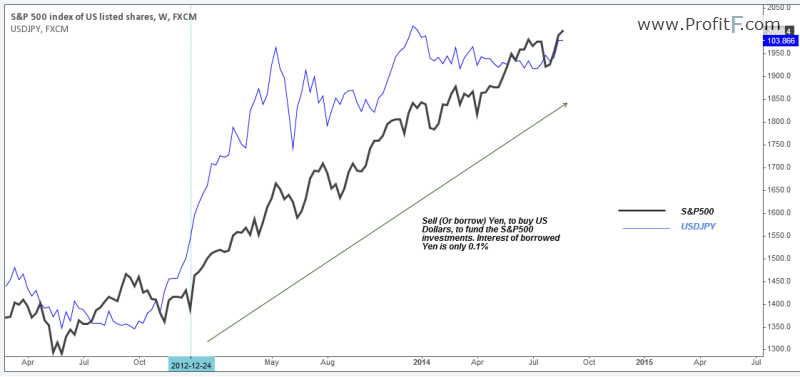Example of currency carry trade
A carry trade is a popular technique among currency traders in which a trader borrows a currency at a low interest rate to finance the purchase of another currency earning a higher interest rate.
Thus, the idea of carry trade in its most general form is trade aimed at trying to generate a profitable return by exchanging two assets with differing relative carrying costs. In a currency carry trade, an investor potentially stands to profit or lose both from the relative movement of the exchange rate and the interest rate differential between the two currencies.
Markets that present a high interest rate differential often present higher currency volatility, and an unexpected weakening of the target currency purchased could generate losses. To be profitable, the interest rate differential of a carry trade must be greater than the possible weakening of the target currency over the period of time that the trade is executed.
Under the economic theory of uncovered interest rate parity UIP , carry trade is not expected to produce a profit because currency values should adjust according to the interest rate differential between two countries. In practice, however, currencies of countries with higher interest rates have been found to appreciate rather than depreciate as the theory states.
The practice of carry trade in currency markets gained popularity in the s. Currency traders, especially at hedge funds, began to see opportunity in the large interest rate differentials between the economies in countries like Japan, Australia and the U.
At the time, interest rates in Japan had dropped near zero, 4 Retrieved 16 September http: Carry trades have been especially popular for investment in emerging markets, which because of their macroeconomic characteristics have tended to present high interest rate differentials.
Currency Carry Trades
At the same time, authorities in those countries have found the practice of carry trade in large volumes to present problems, as it tends to bid up the value of those currencies and then produce a dramatic depreciation when the carry trade positions are later reversed en masse.
Currency carry trades can be made with simple cash transactions involving the purchase of foreign currencies. However, according to the Bank for International Settlements BIS , they are most frequently made through derivatives market operations, including futures , forwards, forex swaps and options.
Also, they are often made over a period of 6 months or less. The common strategies of carry trade that the BIS identifies includes direct acquisition of debt in a high-interest-yielding currency using borrowed funds in a low interest currency. At settlement, the investor sells the debt and repurchases the funding currency to repay the initial amount borrowed. An alternative strategy used by investors is to take a long forward position in the high-interest currency using deliverable forex swaps.
This strategy involves the purchase of the low-interest currency on the spot market and the purchase of the target currency with a forward transaction. At settlement, the investor receives the target currency and delivers the low-interest funding currency, using the proceeds of the transaction to repurchase the funding currency on the spot market. This strategy is considered to offer the advantage that positions can be quickly unwound if needed.
Another popular strategy is to take a non-deliverable short position in a low-yielding currency and a long position in a high-yielding target currency. Upon settlement, the purchaser receives, or pays, the difference between the forward rate and the spot rate if the target currency appreciates or depreciates in relation to the agreed-upon price of the non-deliverable forward.

This strategy is popular because the transaction involving a non-deliverable contract can be made with a relatively smaller initial investment than with alternative strategies.
Leverage can work against you. Be aware and fully understand all risks associated with the market and trading.
Prior to trading any products offered by Forex Capital Markets Limited , inclusive of all EU branches, FXCM Australia Pty. Limited , any affiliates of aforementioned firms, or other firms within the FXCM group of companies [collectively the "FXCM Group"], carefully consider your financial situation and experience level.
If you decide to trade products offered by FXCM Australia Pty.
Currency Carry Trade
Limited "FXCM AU" AFSL , you must read and understand the Financial Services Guide , Product Disclosure Statement , and Terms of Business. The FXCM Group may provide general commentary which is not intended as investment advice and must not be construed as such.
Seek advice from a separate financial advisor. The FXCM Group assumes no liability for errors, inaccuracies or omissions; does not warrant the accuracy, completeness of information, text, graphics, links or other items contained within these materials. The FXCM Group is headquartered at 55 Water Street, 50th Floor, New York, NY USA.
What is a Currency Carry Trade? - aqasesuyohaw.web.fc2.com
Forex Capital Markets Limited "FXCM LTD" is authorised and regulated in the UK by the Financial Conduct Authority. Registered in England and Wales with Companies House company number Limited "FXCM AU" is regulated by the Australian Securities and Investments Commission, AFSL FXCM Markets Limited "FXCM Markets" is an operating subsidiary within the FXCM Group. FXCM Markets is not regulated and not subject to the regulatory oversight that govern other FXCM Group entities, which includes but is not limited to, Financial Conduct Authority, and the Australian Securities and Investments Commission.
FXCM Global Services, LLC is an operating subsidiary within the FXCM Group. FXCM Global Services, LLC is not regulated and not subject to regulatory oversight. Market Insights Currency Markets Commodities Trading Glossary. What Is A Currency Carry Trade?
Franklin Forex Live Carry Trade ExampleThe Forward Premium Puzzle Under the economic theory of uncovered interest rate parity UIP , carry trade is not expected to produce a profit because currency values should adjust according to the interest rate differential between two countries.
FXCM Financials Regulation Code of Conduct. Past Performance is not an indicator of future results. Retrieved 16 September http: